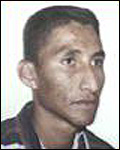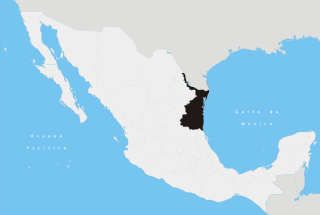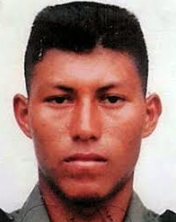
Osiel Cárdenas Guillén is a Mexican drug lord and the former leader of the Gulf Cartel and Los Zetas. Originally a mechanic in Matamoros, Tamaulipas, he entered the cartel by killing Juan García Abrego's friend and competitor Salvador Gómez, after the former's arrest in 1996. As confrontations with rival groups heated up, Osiel Cárdenas sought and recruited over 30 deserters from the Grupo Aeromóvil de Fuerzas Especiales to form the cartel's armed wing. Los Zetas served as the hired private mercenary army of the Gulf Cartel.

Los Zetas is a Mexican criminal syndicate, known as one of the most dangerous of Mexico's drug cartels. They are known for engaging in brutally violent "shock and awe" tactics such as beheadings, torture, and indiscriminate murder. While primarily concerned with drug trafficking, the organization also runs profitable sex and gun rackets. Los Zetas also operate through protection rackets, assassinations, extortion, kidnappings and other illegal activities. The organization is based in Nuevo Laredo, Tamaulipas, directly across the border from Laredo, Texas. The origins of Los Zetas date back to the late 1990s, when commandos of the Mexican Army deserted their ranks and began working as the enforcement arm of the Gulf Cartel. In February 2010, Los Zetas broke away and formed their own criminal organization, rivalling the Gulf Cartel.

The Gulf Cartel is a criminal syndicate and drug trafficking organization in Mexico, and perhaps one of the oldest organized crime groups in the country. It is currently based in Matamoros, Tamaulipas, directly across the U.S. border from Brownsville, Texas.

Jorge Eduardo Costilla Sánchez is a former Mexican drug lord and top leader of the criminal drug trafficking organization known as the Gulf Cartel. He was among Mexico's most-wanted drug lords, until his arrest in 2012.

Antonio Ezequiel Cárdenas Guillén, commonly referred to by his alias Tony Tormenta, was a Mexican drug lord and co-leader of the Gulf Cartel, a drug trafficking organization based in Tamaulipas. He headed the criminal group along with Jorge Eduardo Costilla Sánchez. Antonio was considered by Mexican security forces as one of Mexico's most-wanted men.
Arturo Guzmán Decena, also known by his code name Z-1, was a Mexican Army Special Forces officer and high-ranking member of Los Zetas, a criminal group based in Tamaulipas. He defected from the military in 1997 and formed Los Zetas, the Gulf Cartel's former paramilitary wing, under the leadership of the kingpin Osiel Cárdenas Guillén.

Mario Alberto Cárdenas Guillén is a former leader of the Mexican criminal group called the Gulf Cartel. He is the brother of Osiel Cárdenas Guillén and Antonio Cárdenas Guillén.

Samuel Flores Borrego was a Mexican drug lord and high-ranking lieutenant of the Gulf Cartel. He was a former state judicial policeman who protected the ex-leader of the Gulf cartel, Osiel Cárdenas Guillén. Upon his arrest, Flores Borrego became the right-hand man of Jorge Eduardo Costilla Sánchez, the former leader of the criminal organization.

Mario Armando Ramírez Treviño, commonly referred to by his aliases El Pelón and/or X-20, is a Mexican suspected drug lord and former leader of the Gulf Cartel, a drug trafficking organization.

Los Rojos is a faction of a Mexican drug trafficking organization known as the Gulf Cartel. The group was formed in the late 1990s during the reign of Osiel Cárdenas Guillén, the former leader of the cartel, to provide security to the organization's leaders as the cartel's armed wing.
The 2012 Nuevo Laredo massacres were a series of mass murder attacks between the allied Sinaloa Cartel and Gulf Cartel against Los Zetas in the border city of Nuevo Laredo, Tamaulipas, across the U.S.-Mexico border from Laredo, Texas. The drug-violence in Nuevo Laredo began back in 2003, when the city was controlled by the Gulf Cartel. Most media reports that write about the Mexican Drug War, however, point to 2006 as the start of the drug war. That year is a convenient historical marker because that's when Felipe Calderón took office and carried out an aggressive approach against the cartels. But authors like Ioan Grillo and Sylvia Longmire note that Mexico's drug war actually began at the end of Vicente Fox's administration in 2004, when the first major battle took place in Nuevo Laredo between the Sinaloa Cartel and Los Zetas, who at that time worked as the armed wing of the Gulf Cartel.

The infighting in the Gulf Cartel refers to a series of confrontations between the Metros and the Rojos, two factions within Gulf Cartel that engaged in a power struggle directly after the death of the drug lord Samuel Flores Borrego in September 2011. The infighting has lasted through 2013, although the Metros have gained the advantage and regained control of the major cities controlled by the cartel when it was essentially one organization.

Héctor Manuel Sauceda Gamboa, commonly referred to by his alias El Karis, was a Mexican suspected drug trafficker and high-ranking leader of the Gulf Cartel, a drug trafficking organization based in Tamaulipas. He was the brother of the drug lord Gregorio Sauceda Gamboa, another high-ranking drug trafficker who worked under the tutelage of Osiel Cárdenas Guillén, the former top leader of the cartel. El Karis took the lead of the Gulf Cartel in Reynosa following the arrest of Jaime González Durán, a leader of Los Zetas drug cartel, in November 2008.
Homero Enrique Cárdenas Guillén, also known by his aliases El Majadero and El Orejón, was a Mexican suspected drug lord and alleged leader of the Gulf Cartel, a drug trafficking organization. He is the brother of the former Gulf Cartel leaders Antonio, Mario, and Osiel Cárdenas Guillen. During the late 1990s, Homero worked for the Gulf Cartel under the tutelage of his brothers. However, after several years of government crackdowns, the Gulf Cartel suffered severe drawbacks, including the death and arrests of Homero's brothers and allies. In August 2013, Homero became the de facto leader of the Gulf Cartel following the arrest of Mario Ramírez Treviño. However, he reportedly died of a heart attack on 28 March 2014.

On 9 November 1999, two agents from the United States Drug Enforcement Administration (DEA) and Federal Bureau of Investigation (FBI) were threatened at gunpoint and nearly killed in Matamoros, Tamaulipas, Mexico, by gunmen of the Gulf Cartel, a criminal group based in the area. The two agents traveled to Matamoros with an informant to gather intelligence on the operations of the Gulf Cartel. As they cruised through one of the properties owned by the criminal group, they noticed several vehicles following them. The agents were forced to a stop and were corralled by a convoy of eight vehicles, from which fifteen gunmen emerged and surrounded the agents' car. Some of them wore uniforms of the local police. Among the gunmen was the former kingpin Osiel Cárdenas Guillén, who recognized the informant and ordered the three of them to get out of their vehicle.

Juan Carlos de la Cruz Reyna is a Mexican convicted criminal and former high-ranking member of the Gulf Cartel, a criminal group based in Tamaulipas, Mexico. He was also a senior member in Los Zetas, the Gulf Cartel's former paramilitary group. In the 1990s, de la Cruz Reyna was an officer in the Tamaulipas State Police while working as a hitman for the Gulf Cartel. After he left the agency in 1999, he became a bodyguard for former Gulf Cartel kingpin Osiel Cárdenas Guillén, and was eventually promoted to regional leader of the cartel in Tampico. He reportedly had policemen on his payroll, and managed international drug trafficking shipments from Central and South America.

Víctor Manuel Vázquez Mireles is a Mexican drug lord and high-ranking member of the Gulf Cartel, a criminal group based in Tamaulipas, Mexico. Vázquez Mireles joined the cartel during the 1990s and was a trusted enforcer of former kingpin Osiel Cárdenas Guillén. He started his career in the cartel as one of his bodyguards and was eventually placed in charge of operations in Tamaulipas and Veracruz. He was reportedly responsible for supervising the purchase of drugs intended to be smuggled into the U.S. for distribution and for arranging the assistance of corrupt law enforcement officials in the cartel's operations.

Raúl Hernández Barrón, also known by his alias Flanders 1, was a Mexican suspected drug lord and high-ranking member of Los Zetas, a criminal group based in Tamaulipas, Mexico. Hernández Barrón served in the Mexican Army from 1993 to 1999 as an infantry soldier. He then left and joined the Gulf Cartel under the kingpin Osiel Cárdenas Guillén, and became part of the first members of their newly formed paramilitary wing, Los Zetas. Like Hernández Barrón, most of the first members of Los Zetas were ex-military. Los Zetas was responsible for providing security services to Cárdenas Guillén and carrying out executions on the cartel's behalf. Hernández Barrón was also responsible for coordinating drug trafficking activities in Veracruz.

Raúl Alberto Trejo Benavides was a Mexican suspected drug lord and high-ranking member of Los Zetas, a criminal group based in Tamaulipas, Mexico. Trejo Benavides served in the Mexican Army from 1991 to 1999, and was a member of the Grupo Aeromóvil de Fuerzas Especiales (GAFE), the army's special forces. He joined the Gulf Cartel under kingpin Osiel Cárdenas Guillén after leaving the army, becoming one of the first members of its newly formed paramilitary wing, Los Zetas. Like Trejo Benavides, most of the first members of Los Zetas were ex-military. Los Zetas was responsible for providing security services to Cárdenas Guillén and carrying out executions on the cartel's behalf.

The Battle of Ruíz was one of the most violent clashes between criminal organizations in Mexico between Sinaloa Cartel and Los Zetas.












